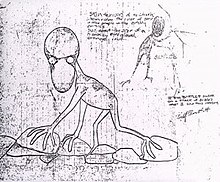Introduction
In the annals of cryptozoology and local folklore, few creatures stir up as much intrigue as the Dover Demon. This mysterious creature, sighted only for a brief period in the late 1970s, has nonetheless left an indelible mark on popular culture.
This article aims to unearth the history of the sightings, the public reaction, and the ongoing mystery surrounding the Dover Demon.
The Dover Demon Sightings
In April 1977, Bill Bartlett, a 17-year-old from Dover, Massachusetts, was driving home from work late in the evening when he had a bizarre encounter. Along Farm Street, he spotted what he initially assumed to be an ordinary animal, possibly a dog or a cat, sitting on a stone wall near the road. As he approached, he quickly realized that the creature was unlike anything he had ever seen before.
The creature, later referred to as the Dover Demon, stood about 4 feet tall and had an unusual appearance. Its body was thin and elongated, with spindly limbs that seemed out of proportion. The Dover Demon had glowing, orange eyes that reflected in the headlights of Bartlett’s car. Its skin was hairless, and it had a rough, sandpaper-like texture. The creature’s head was unusually large with no visible nose or mouth, and its ears were pointed and reminiscent of a cat’s.
Bill Bartlett watched in astonishment for about a minute before deciding to drive away to seek help from his friend, John Baxter.
Later that same evening, Bill Bartlett and John Baxter returned to the site of the sighting in an attempt to investigate further. They claimed to have seen the Dover Demon again, this time from a distance. However, they didn’t approach too closely and watched the creature disappear into the woods.

The next night, on April 22, 1977, another teenager named Abby Brabham, aged 15, had her own encounter with a similar creature. She saw a small, greyish figure with glowing eyes standing on the edge of the road on Springdale Avenue in Dover. Like the previous sightings, the creature vanished before she could get a closer look.
News of the Dover Demon sightings spread, and it captured the attention of both the media and cryptozoologists. The mysterious encounters generated significant interest and speculation about the true nature of the creature. Some proposed that it could have been a misidentified animal, such as a young moose or a dog with mange. Others entertained the possibility of an extraterrestrial being or a cryptid unknown to science.
Despite numerous investigations and discussions, the Dover Demon remains an unsolved mystery, and the truth behind the sightings continues to elude researchers. The case is often cited as one of the most compelling examples of cryptid encounters in the United States, and it has maintained its intrigue among enthusiasts and skeptics alike for many years.
Read Also: The Witch House
Public Reaction and Impact
Following the initial sightings, local and national media were quick to pick up the story. The name ‘Dover Demon‘, coined by cryptozoologist Loren Coleman, added a further layer of mystery and intrigue. Residents of Dover and neighboring towns were split between alarm, skepticism, and dismissal.
In the years since, the Dover Demon has become a facet of local lore, attracting the interest of paranormal enthusiasts and tourists alike. Its impact on Dover has been multifaceted, shifting from initial fear and apprehension to a source of intrigue and local identity.
Investigation and Explanations
Over the years, several explanations and theories have been proposed to make sense of the mysterious sightings. One school of thought posits that the witnesses may have simply misidentified ordinary wildlife under unusual lighting conditions. Animals like young deer, coyotes, or dogs with certain physical conditions, such as mange, could potentially match some aspects of the Dover Demon‘s description. These natural explanations suggest that the witnesses’ perceptions might have been influenced by environmental factors.
Another hypothesis suggests that the Dover Demon sightings might have been part of a hoax or prank played by the witnesses or other individuals seeking attention or amusement. However, there is a lack of concrete evidence to support the notion of intentional deception. Nonetheless, skeptics have pointed to the possibility of these encounters being mere fabrications.

Alternatively, some researchers and psychologists have considered the idea of mass hysteria or shared delusion. This explanation proposes that the initial report of the Dover Demon influenced others in the community to perceive similar phenomena, even if they did not actually witness anything unusual themselves. In this view, social and psychological factors could have contributed to the spread of the sightings.
Stepping into the realm of the speculative, some cryptozoologists entertain the possibility that the Dover Demon might be an unidentified cryptid or unknown creature yet to be recognized or classified by science. Cryptids are creatures that have been reported in folklore, but for which there is no scientific evidence. This theory suggests that the creature could belong to an undiscovered species, hiding in the shadows of our understanding.
On the more paranormal end of the spectrum, enthusiasts have suggested the idea of the Dover Demon being an extraterrestrial being visiting Earth or a supernatural entity with inexplicable abilities. These explanations, while intriguing, fall into the realm of the unknown, with little tangible evidence to substantiate them.
Dover Demon in Popular Culture
The Dover Demon has since found a place in popular culture, with appearances in books, movies, and television series. Its portrayal often leans into the mystery and horror of the original sightings, maintaining the creature’s unnerving, cryptic image.
From comic books like ‘The Strange Adventures of H.P. Lovecraft‘ to TV shows such as ‘Lost Tapes‘, the Dover Demon continues to captivate audiences with its eerie presence.
Conclusion
More than four decades after its first sighting, the Dover Demon remains a captivating figure in the realm of cryptozoology and local folklore. Its brief appearance and enduring mystery serve as a testament to the human fascination with the unknown.
Whether it was a fleeting visitor from another world, a misidentified animal, or a town-wide deception, the Dover Demon continues to be an enigmatic symbol of Dover, forever a part of its historical and cultural fabric.
In the realm of the inexplicable and unknown, the Dover Demon stands as an enduring enigma, a creature of mystery forever etched into the history of Dover, Massachusetts.






